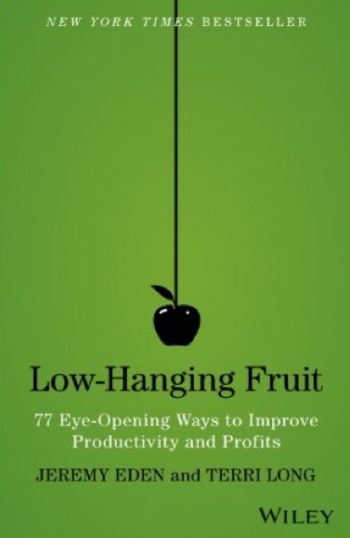Rethink your business and then rebuild
Book Review: Better management in 77 bite-sized chunks
- |
- Written by Andy Schornack
- |
- Comments: DISQUS_COMMENTS
 Low Hanging Fruit: 77 Eye-Opening Ways to Improve Productivity and Profits. By Jeremy Eden and Terri Long. Wiley. 200 pp.
Low Hanging Fruit: 77 Eye-Opening Ways to Improve Productivity and Profits. By Jeremy Eden and Terri Long. Wiley. 200 pp.
“Companies around the world have grown bigger over the years, but they have not become better. In fact, as most companies grow, they become less than the sum of their parts. Incredible advances in technology have not provided the Holy Grail of making work easier. Employees feel as though they are working harder than ever. Yet the companies they work for often move at a snail’s pace and are more conducive to stagnation than innovation—focused more on politics than on profit.”—Jeremy Eden and Terri Long
We are creatures of habit at home and at work. Authors Jeremy Eden and Terri Long, business consultants, have provided a fast read to reaffirm ways to drive results in our financial institutions.
The book leads the reader to invest in driving a “good cash crop yield” in their business. The six areas the authors suggest business leaders focus on:
1. Providing problem solving skills
2. Motivating employees
3. Organizing collaboration across units
4. Making decisions quickly
5. Building implementation skills
6. Creating accountability to deliver hard dollar benefits
The focal point is that weakness in any one of these six areas leads to an overall weakness in business innovation and success or the “idea yield multiplier.” The 77 vignettes that make up most of the book focus on tactical strategies to improve each area to maximize yield at the company.
As a financial institution manager, I always look for ideas that apply to my business and how we can improve. There are several tactics from the book that I found especially interesting. Let’s take a closer look.
The 5 “Whys”
Banks’ operations encompass many routine transactions and historical traditions. That is a strength but can also be a weakness. How often do we hear, “That is how we have always done it” or “That’s against policy.”
As we are looking to solve problems, the question should be “How do we know that is true?” The follow up is “Why?”
In fact, the authors recommend asking “why” five times, until the other person confesses they don’t know the right answer. “That is when you will make real progress toward finding the right problem to solve,” they write.
Focus on fact-based information and use this information to derive solutions. It may be the policy or the traditional process but if the waves it creates result in problems perhaps there are better, more efficient ways to take action while meeting regulatory guidelines and accomplishing success without the aftereffects.
Creating the right environment
I agree with the authors that our “goal is to provide the right environment and the right process” so our employees are able to use their talents to solve the company’s business process problems.
There are no revolutionary thoughts in the motivation section of this book. Tried and true, the focus of what’s here is to reassure management that they should be pushing down idea generation to those closest to the problems; going out to see the problems for themselves; and encouraging cross-functional and supply chain interactions to generate ideas and find ways to improve processes to drive better results.
Lastly, management should provide the power to execute on the idea: “This is great. I’m really glad you’re going to fix this problem.”
The authors cited Peter Drucker’s quote that “There is nothing so useless as doing efficiently that which should not be done at all.”
That’s a great lesson in operating efficiently. As leaders, we can’t get tied to a project if the data now indicates the project no longer provides value. It has to be stopped.
Simplify
As a guy who enjoys simplicity in a complex environment, I applaud the author’s indication to not only focus on offerings, communication, but to accept simple and low-tech over sexy and high-tech.
Financial institutions are facing proposals for upgrades and new data mining tools every day. As outlined in an example in the book, sometimes an employee with reliable Excel knowledge can still get the job done without ballooning the technology budget.
Sweat the small stuff
How often do we review the processes and procedures a customer experiences when they enter our banks? Do we look for ways to make this process easier for them by streamlining applications or by using terms that are customer-friendly?
The authors make a case that this is the difference between the good and the truly great.
Steve Jobs created a culture of detail at Apple. This focus didn’t stop at product design but also included supply chain management and business processes. The ultimate challenge is to use detail and thorough understanding to control costs while maximizing benefits.
Track every idea, every dollar, every month
The authors encourage the reader to follow who, what, when, and why on idea implementation and accountability. The tracker should be independent and ensure ideas are creating the intended value and notify others if they are not.
Follow the money, put a price tag on everything.
The pure force of the exercise the authors infer will drive hard-dollar accountability and deter soft-dollar commitments.
A quick read with timely reminders
It’s no surprise that Low Hanging Fruit has been named a New York Times best seller. It’s efficient and sufficiently highlights 77 tactical strategies to improve your business.
In a normal weekend, it will challenge your management style and provide you with a pathway to improve your business’s idea-generation and problem-solving skills. Although I don’t consider all 77 short chapters as eye-opening as the title suggests, I did enjoy the book.
Tagged under Management, Duties, Blogs, Books for Bankers,














